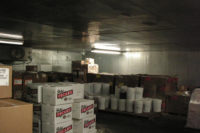Flying cheese, sausage and even pizza crusts are not the way GLV Foods (Neptune, NJ) envisioned freezing its Upper Krust Pizza brand products. GLV's original in-line freezer with high-speed, non-adjustable fans not only blew cheese off the lightweight crust but sent crusts flying around the freezer as well. Because the company recently moved into a new 23,000-sq.-ft. facility and is producing more than 15,000 pizzas a week, it needed a fast cooling solution.
"With our business growing at a rapid pace, both foodservice and retail, we could not afford the waste and inefficiency our freezing system was causing to overall pizza cost," says Phil Cierzo, company CEO. "We called in Air Liquide for help."
Air Liquide's immediate answer: an in-line nitrogen freezer with variable speed fans freezing ready-to-cook pizzas in 90 seconds. "Freezing at slower rates allows migration of sauce into the dough," adds Cierzo. "Subsequently, such freezing forms large ice crystals destroying the texture and mouthfeel of finished pizza. Rapid freezing prevents this and maintains fresh taste and texture."
Next, Air Liquide developed a unique customized billing system for GLV, which documents freezer belt run-time and calculates cost on a per pizza basis. The supplier's Datal hardware/software package helps maintain correct freezer temperature, monitors belt run-time and alerts the user to any discrepancies in usage that could indicate operating problems. The expandable system includes an interface with the supplier for troubleshooting and automatic gas replenishment.
"Actual freezing cost per pizza was about 33 cents on our old system, which includes rental costs of the freezer and gas tank," notes Cierzo. "With new Air Liquide equipment and Datal system, we now pay only a few cents per pizza for freezing, with no additional cost for gas, storage tank or freezer. The system bases calculations on optimum retention time for freezing pizzas and run time of the freezer belt per month. Costing through this method entices us to be as efficient as possible and also gives us a consistent freezing cost allocation within the total cost of production."


